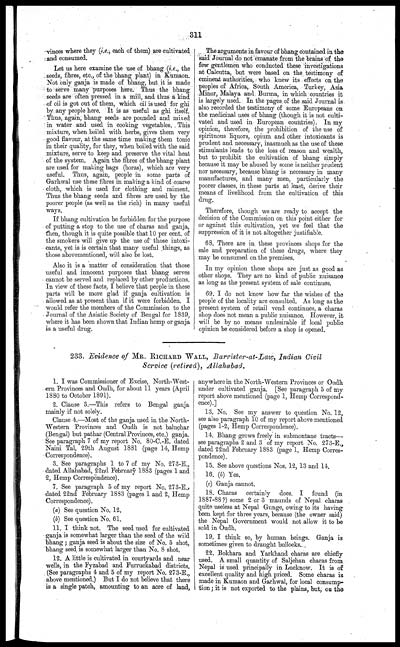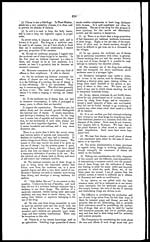Medicine - Drugs > Report of the Indian Hemp Drugs Commission, 1894-1895 > Volume V
(331) Page 311
Download files
Individual page:
Thumbnail gallery: Grid view | List view

311
vinces where they (i.e., each of them) are cultivated
and consumed.
Let us here examine the use of bhang (i.e., the
seeds, fibres, etc., of the bhang plant) in Kumaon.
Not only ganja is made of bhang, but it is made
to serve many purposes here. Thus the bhang
seeds are often pressed in a mill, and thus a kind
of oil is got out of them, which oil is used for ghi
by any people here. It is as useful as ghi itself.
Thus, again, bhang seeds are pounded and mixed
in water and used in cooking vegetables. This
mixture, when boiled with herbs, gives them very
good flavour, at the same time making them tonic
in their quality, for they, when boiled with the said
mixture, serve to keep and preserve the vital heat
of the system. Again the fibres of the bhang plant
are used for making bags (boras), which are very
useful. Thus, again, people in some parts of
Garhwal use these fibres in making a kind of coarse
cloth, which is used for clothing and raiment.
Thus the bhang seeds and fibres are used by the
poorer people (as well as the rich) in many useful
ways.
If bhang cultivation be forbidden for the purpose
of putting a stop to the use of charas and ganja,
then, though it is quite possible that 10 per cent. of
the smokers will give up the use of those intoxi-
cants, yet is is certain that many useful things, as
those abovementioned, will also be lost.
Also it is a matter of consideration that those
useful and innocent purposes that bhang serves
cannot be served and replaced by other productions.
In view of these facts, I believe that people in these
parts will be more glad if ganja cultivation is
allowed as at present than if it were forbidden. I
would refer the members of the Commission to the
Journal of the Asiatic Society of Bengal for 1839,
where it has been shown that Indian hemp or ganja
is a useful drug.
The arguments in favour of bhang contained in the
said Journal do not emanate from the brains of the
few gentlemen who conducted these investigations
at Calcutta, but were based on the testimony of
eminent authorities, who knew its effects on the
peoples of Africa, South America, Turkey, Asia
Minor, Malaya and Burma, in which countries it
J is largely used. In the pages of the said Journal is
also recorded the testimony of some Europeans on
the medicinal uses of bhang (though it is not culti-
vated and used in European countries). In my
opinion, therefore, the prohibition of the use of
spirituous liquors, opium and other intoxicants is
prudent and necessary, inasmuch as the use of these
stimulants leads to the loss of reason and wealth,
but to prohibit the cultivation of bhang simply
because it may be abused by some is neither prudent
nor necessary, because bhang is necessary in many
manufactures, and many men, particularly the
poorer classes, in these parts at least, derive their
means of livelihood from the cultivation of this
drug.
Therefore, though we are ready to accept the
decision of the Commission on this point either for
or against this cultivation, yet we feel that the
suppression of it is not altogether justifiable.
63. There are in these provinces shops for the
sale and preparation of these drugs, where they
may be consumed on the premises.
In my opinion these shops are just as good as
other shops. They are no kind of public nuisance
as long as the present system of sale continues.
69. I do not know how far the wishes of the
people of the locality are consulted. As long as the
present system of retail vend continues, a charas
shop does not mean a public nuisance. However, it
will be by no means undesirable if local public
opinion be considered before a shop is opened.
233. Evidence of MR. RICHARD WALL, Barrister-at-Law, Indian Civil
Service (retired), Allahabad.
1.I was Commissioner of Excise, North-West-
ern Provinces and Oudh, for about 11 years (April
1880 to October 1891).
2.Clause 3.—This refers to Bengal ganja
mainly if not solely.
Clause 4.—Most of the ganja used in the North-
Western Provinces and Oudh is not baluchar
(Bengal) but pathar (Central Provinces, etc.) ganja.
See paragraph 7 of my report No. 80-C.-E. dated
Naini Tal, 29th August 1881 (page 14, Hemp
Correspondence).
3.See paragraphs 1 to 7 of my No. 273-E.,
dated Allahabad, 22nd February 1883 (pages 1 and
2, Hemp Correspondence).
7. See paragraph 5 of my report No. 273-E.,
dated 22nd February 1883 (pages 1 and 2, Hemp
Correspondence).
(a)See question No. 12.
(b)See question No. 61.
11.I think not. The seed used for cultivated
ganja is somewhat larger than the seed of the wild
bhang; ganja seed is about the size of No. 5 shot,
bhang seed is somewhat larger than No. 8 shot.
12.A little is cultivated in courtyards and near
wells, in the Fyzabad and Furruckabad districts.
(See paragraphs -1 and 5 of my report No. 273-E.,
above mentioned.) But I do not believe that there
is a single patch, amounting to an acre of land,
anywhere in the North-Western Provinces or Oudh
under cultivated ganja. [See paragraph 5 of my
report above mentioned (page 1, Hemp Correspond-
ence).]
13.No. See my answer to question No. 12,
see also paragraph 10 of my report above mentioned
(pages 1-2, Hemp Correspondence).
14.Bhang grows freely in submontane tracts—
see paragraphs 2 and 3 of my report No. 273-E.,
dated 22nd February 1883 (page I, Hemp Corres-
pondence).
15.See above questions Nos. 12, 13 and 14.
16.(b) Yes.
(c)Ganja cannot.
18.Charas certainly does. I found (in
1887-88?) some 2 or 3 maunds of Nepal charas
quite useless at Nepal Gunge, owing to its having
been kept for three years, because (the owner said)
the Nepal Government would not allow it to bo
sold in Oudh.
19.I think so, by human beings. Ganja is
sometimes given to draught bullocks.
22.Bokhara and Yarkhand charas are chiefly
used. A small quantity of Saljchan charas from
Nepal is used principally in Lucknow. It is of
excellent quality and high priced. Some charas is
made in Kumaon and Garhwal, for local consump-
tion; it is not exported to the plains, but, on the
Set display mode to: Large image | Zoom image | Transcription
Images and transcriptions on this page, including medium image downloads, may be used under the Creative Commons Attribution 4.0 International Licence unless otherwise stated. ![]()
| India Papers > Medicine - Drugs > Report of the Indian Hemp Drugs Commission, 1894-1895 > Volume V > (331) Page 311 |
|---|
| Permanent URL | https://digital.nls.uk/75121821 |
|---|
| Description | Volume 5: Evidence of witnesses from North-Western Provinces and Oudh and Punjab. Answers from witnesses in North-Western Provinces, Oudh and Punjab about cultivation and growth of hemp, preparation or manufacture, trade, consumption or use, effects, administration - taxation and control. |
|---|---|
| Attribution and copyright: |
|




